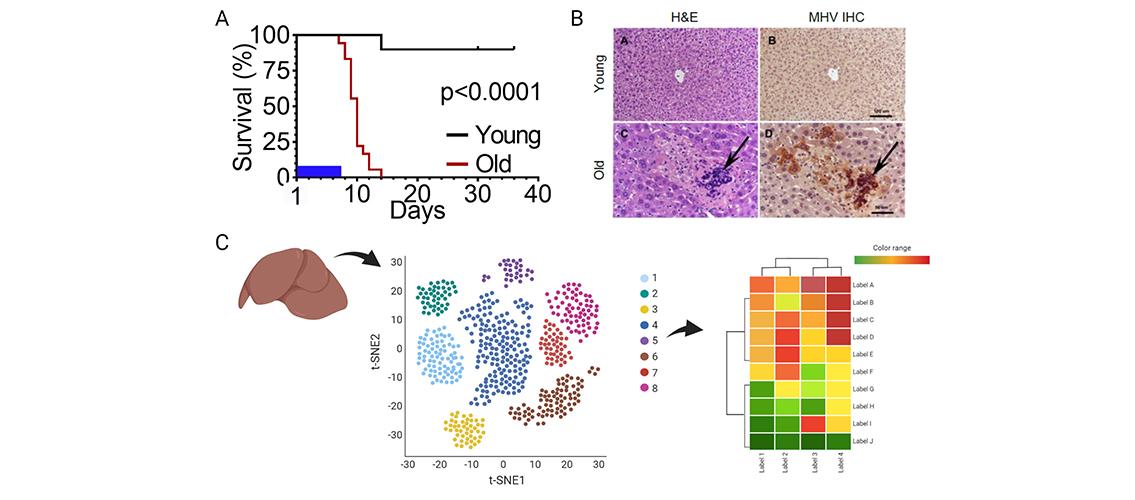
The elderly and those with chronic diseases demonstrate a two to ten-fold increased risk of hospitalization and elevated mortality in the setting of multiple types of infections, including SARS-CoV-2, influenza, and pneumonia. Co-infections or secondary infections are also more abundant in the elderly and contribute to excessive mortality. This is especially evident in the current COVID-19 pandemic, where the elderly are among the most at risk groups for mortality and morbidity upon infection with SARS-CoV-2. The precise mechanisms behind infection-related mortality in elderly individuals are unknown, but elevated inflammatory factors suggests that mortality might be due, in part, to a virus-activated cytokine storm. Death from cytokine storm and associated acute respiratory distress syndrome (ARDS) and myocarditis are seen in older and chronically ill individuals.
MSI PI Christina Camell (assistant professor, Biochemistry, Molecular Biology and Biophysics) and her lab have taken advantage of a unique mouse model that exposes mice to multiple microbes (termed normal microbial experience, or NME) at the University of Minnesota. Critically, the NME model generates functional immune memory in young mice that leads to a more diverse immune system. Aged mice that are exposed to NME show 100% mortality (image, A). The researchers can reduce mortality using senolytics to deplete senescent cells or immunotherapeutics to target immune cells. Their data show the liver is a major site of viral infection, including infection with the coronavirus and mouse hepatitis virus (image, B). They have seen increases in inflammatory markers, an elevated frequency of immune cell infiltrates, and increased expression of markers for senescence cells in the liver of the aged NME-exposed mice as compared to the young NME-exposed mice. These are all contributing components to the cytokine storm and mortality seen in the aged NME exposed mice. The Camell Lab worked with the University of Minnesota Genomics Center to perform bulk sequencing on the livers of young and old, specific pathogen free (SPF) and NME-exposed mice. Pathway analysis identified the upregulation of multiple pathways associated with immune activation and inflammation. This analysis has the advantage of containing the transcriptional profile of all cells, including immune cells, hepatocytes, and senescent cells, which are lost or altered during the laborious single cell preparation from the liver, but the researchers are unable to identify the cell type to which specific genes belong.
To address this lack of specificity in the bulk RNA sequencing data, the Camell Lab is collaborating with Dr. Christy Henzler in MSI’s Research Informatics Solutions group, who will perform cell type deconvolution on bulk RNA-seq data to differentiate non-immune (largely hepatocyte) and immune cells. Bulk deconvolution can accurately decompose bulk RNA-seq samples into their component parts, at least into immune vs. non-immune cell types, and ideally more specifically into more detailed sub-types of immune and non-immune cells (image, C). These deconvoluted datasets can then be used successfully to analyze differential expression of specific cell types between combinations of young and old and SPF and dirty groups of mice. The deconvolution is the only path that will analyze all cell types and has the additional benefit of avoiding any tissue manipulation. This project recently received a UMII Seed Grant.
Image Description. Infection associated mortality in old mice. A. Survival curve of young and old mice exposed to normal microbial experience (NME) for 7 days. B. Hematoxicylin and eosin (H&E) and immunohistochemistry for mouse hepatitis viral proteins in the liver of young or old mice exposed to NME for 7 days. Arrows point to necrotic hepatocytes and positive staining for MHV viral protein in the old mice. C. Schematic to depict the proposed analysis to deconvolute the liver, which is highly heterogeneous.
posted on September 27, 2022